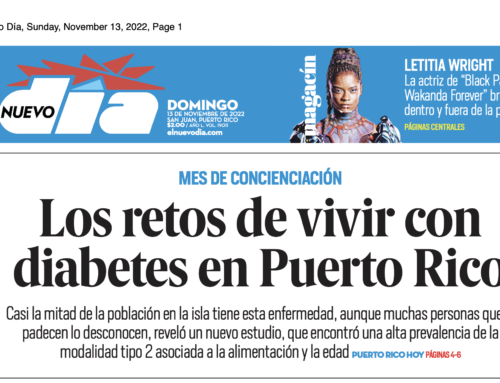Diabetes Prevalence in Puerto Rico Potentially Much Higher than Official Estimate
According to a new analysis performed as part of a new alliance between Abartys Health and the Puerto Rico Diabetes Association
San Juan, Puerto Rico – The prevalence of diabetes in Puerto Rico could be much higher than official estimates, according to a cross-sectional analysis conducted by health technology provider Abartys Health and the Puerto Rico Diabetes Association. The analysis also measured for the first time the prevalence of prediabetes in the island’s population.
The analysis revealed that for the year 2021, Puerto Rico had an estimated diabetes prevalence of over 19.3% among adults 20 years old or higher, based on anonymous clinical data of over 800,000 people within Puerto Rico. Moreover, the estimated diabetes prevalence for September 2022 stands at 20.0%, a figure that is significantly higher than the latest officially reported number of 15.8%, and also higher than the prevalence of the disease in the United States of 14.7%, according to data from the CDC.
“This is the first time that diabetes prevalence in Puerto Rico has been analyzed at this scale, allowing us to see tendencies based on real-world data. Current official figures rely on self-reported information from phone-based surveys alone and do not account for undiagnosed cases, giving us an incomplete picture”, stated Florian Gaa, General Manager of Abartys Health. “In the management of diabetes in the overall population, we advocate for a larger emphasis on data and prevention.”
“Diabetes is a significant health challenge as it greatly increases overall mortality and healthcare costs across all affected populations,” said Brenda Padilla, Executive Director of the Diabetes Association. “We want to bring awareness to what is really a health crisis and at the same time place new tools at the disposal of health authorities, providers and patients,” said Padilla.
The analysis also points to a high prediabetes prevalence in Puerto Rico, which increased from 25.7% to 28.6% during the period from 2019 to 2022, which, together with cases of patients already diagnosed with diabetes, means that almost 50% of the population is currently impacted by the condition.
Diabetes is known to be a major cause of blindness, kidney failure, heart attacks, stroke, and lower limb amputation. Furthermore, it also increases the risk of death associated with COVID19, according to an increasing number of studies.
The reported findings are based on a clinical data review encompassing over 2.6 million lab results for the period from 2019 to September 2022. The review was conducted anonymously on a population of non-identifiable unique patients, in strict compliance with applicable local and federal regulations.
According to the findings, the prevalence of chronic kidney disease (CKD) for the year 2022 was 24.0% in the population with diabetes, compared to 9.4% in the population with normal glucose levels. CKD was observed as being 3.2 imes more likely in people with diabetes than people with normal glucose levels. Likewise, low levels of HDL (high-density lipoprotein) or “good” cholesterol” and high triglyceride levels were found to be 2 and almost 3 times, respectively, more likely in people with diabetes than in those with normal glucose levels.
In terms of geography, the ten municipalities with the current highest diabetes prevalence are Camuy, Quebradillas, Hatillo, Lares, Yauco, Utuado, Arecibo, San Lorenzo, Adjuntas and Lajas.
To complete the data review and corresponding analysis, Abartys Health worked closely with the Puerto Rico Diabetes Association to develop the first clinical dashboard for the management of the condition on the island. The dashboard, based on the company’s clinical insight platform ClinicLynk, offers real-time information, providing a general assessment of the condition by gender, geography, age, health insurers, and medical providers, among other factors.
“Typically, 70% of clinical decisions are made with lab data and now we have real-time, precise visibility on diabetes and prediabetes prevalence and incidents based on real-world data. This allows us to take action to catch and manage prediabetes cases on time, helping to avoid the worsening of the condition. Together with public health authorities, we can also better plan, implement and measure prevention programs,” said Padilla.
The diabetes clinical data dashboard also allows the identification of the relationship between diabetes and other conditions and provides insights into screening rates, risk factors, and possible gaps in care. “With this kind of data analytics,” Gaa explained, “healthcare professionals can better understand patient needs and better allocate resources.”
To measure the prevalence of diabetes, the government of Puerto Rico currently relies on the Behavioral Risk Factor Surveillance System (PRBRFSS) from the CDC which consists on a system of telephone health surveys that collects information on health risk behaviors, preventive health practices, and health care access primarily related to chronic disease and injury. The survey was established in 1984.
About Abartys Health
Since 2016, clinical data management firm Abartys Health has been working to solve the breakdowns in healthcare. Abartys has built a secure and privacy-compliant platform to improve healthcare data interoperability between labs, patients, and providers, enabling actionable data insights and better patient outcomes. For more information, visit www.abartyshealth.com.
About the Puerto Rican Diabetes Association (APD)
APD is a non-profit organization, 501c3, that was established in 1988 with the mission of promoting the prevention, control, and diagnosis of diabetes, empowering patients, families, health professionals and the community in general through education. For more information, you can write to informacion@diabetespr.org, call (787) 729-2210 or 1-800-281-0617, or access www.diabetespr.org
###


